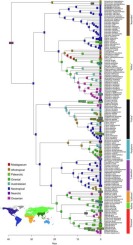Jim LeNomenclatoriste
Je suis un mignon petit Traquet rubicole

Someone should warn Barry Taylor to correct the name "Mentrocrex" to Mentocrex on BOW




Garcia-R. J.C. & Matzke N.J. (2021):Garcia-R. J.C. & Matzke N.J. (2021). Trait-dependent dispersal in rails (Aves: Rallidae): Historical biogeography of a cosmopolitan bird clade. Molecular Phylogenetics and Evolution, available online 16 February 2021, In press.

Trait-dependent dispersal in rails (Aves: Rallidae): Historical biogeography of a cosmopolitan bird clade
The ability of lineages to disperse over evolutionary timescales may be influenced by the gain or loss of traits after adaptation to new ecological co…www.sciencedirect.com
Abstract
The ability of lineages to disperse over evolutionary timescales may be influenced by the gain or loss of traits after adaptation to new ecological conditions. For example, rails (Aves: Rallidae) have many cases of flightless insular endemic species that presumably evolved after flying ancestors dispersed over large ocean barriers and became isolated. Nonetheless, the details of how flying and its loss have influenced the clade’s historical biogeography are unknown, as is the importance of other predictors of dispersal such as the geographic distance between regions. Here, we used a dated phylogeny of 158 species of rails to compare trait-dependent and trait-independent biogeography models in BioGeoBEARS. We evaluated a probabilistic historical biogeographical model that allows geographic range and flight to co-evolve and influence dispersal ability on a phylogeny. The best-fitting dispersal model was a trait-dependent dispersal model (DEC+j +x+t21+m1) that accrued 85.2% of the corrected Akaike Information Criterion (AICc) model weight. The distance-dependence parameter, x was estimated at -0.54, ranging from -0.49 to -0.65 across models, suggesting that a doubling of dispersal distance results in an approximately 31% decrease in dispersal rate (2-0.54 = 0.69). The estimated rate of loss of flight (t21) was similar across all models (∼0.029 loss events per lineage per million years). The multiplier on dispersal rate when a lineage is non-flying, m1, is estimated to be 0.38 under this model. Surprisingly, the estimate of m1 was not 0.0, probably because the loss of flight is so common in the rails that entire clades of flightless species are found in the data, forcing the model to attribute some dispersal to flightless lineages. These results indicate that long-distance dispersal over macroevolutionary timespans can be modelled, rather than simply attributed to chance, allowing support for different hypotheses to be quantified and model limitations to be identified. Overall, by combining new analytical methods with a comprehensive phylogenomic dataset, we use a quantitative framework to show how traits influence dispersal capacity and eventually shape geographical distributions at a macroevolutionary scale.
Typo: Porzana servernsi should be P. severnsiThe only major difference, apart from the inclusion of numerous extinct and extant species added for the first time in a robust phylogenetic framework, is that species within Gymnocrex are shown as sister taxa of Himantornis haemotopus. This result hinges on morphological data from Gymnocrex species, and this clade forms a basal split, making it the sister of all remaining clades.

I need absolutely this paper and the figure. its a question of life or deathGarcia-R. J.C. & Matzke N.J. (2021):
Typo: Porzana servernsi should be P. severnsi
Haha, me too! Tried to discern the tree from the fuzzy figures, but it gave me a headache to say the least.I need absolutely this paper and the figure. its a question of life or death



- Fold Creciscus and Hapalocrex in Laterallus (no new genus for exilis needed)
- Fold Tricholaema*

Do they say which ssp of Woodford's Rail they sampled, that was not sister to the Isabel one, Bougainville, Guadalcanal or Malaita?
- Santa Isabel Rail is sister to Snoring Rail, not at all part of Solomon Rail! I’m sceptical though, could this be right?
Interesting. Gough moorhens brought to zoos in Europe in the late 20. century freely hybridized with local moorhens and the breeding program was lost.
- The Tristan & Gough moorhens (+Hodgen's Waterhen in NZ!) are outside Gallinula+Fulica, just like Paragallinula. Three young branches of moorhen that essentially are identical. Add to that the odd moorhen-like Red-fronted Coot and it appears the coots are nothing but odd moorhen.
Aphanapteryx (1868) is older than Cabalus (1872)Fold Tricholaema, Aphanapteryx and Capellirallus in Cabalus
Will be interesting to see the SACC discussion on this. 1 genus is the conservative approach, but 4 genus-approach seems to line up nice:Fold Creciscus and Hapalocrex in Laterallus (no new genus for exilis needed)
Previous species taken out of Gallinula was to keep this from happening, so I doubt this will happen. Also don't see the point in breaking up Laterallus or Zapornia if these are merged.* Fold Gallinula, Porphyriornis and Paragallinula in Fulica (keeps the Atlantic moorhen in Gallinula)
Agreed, I don't see the need touch RallusKeep Rallus intact (no Epirallus)
Ah, that settles it.Aphanapteryx (1868) is older than Cabalus (1872)

I will review that x)Agreed, I don't see the need touch Rallus

Isn't there a problem with your comment buddy ?* Fold Gallinula, Porphyriornis and Paragallinula in Fulica (keeps the Atlantic moorhen in Gallinula)
Haha, sure is! Skip the parenthes-part, have no idea what I meant there.Isn't there a problem with your comment buddy ?
They have Gallirallus woodfordi as sister to Gallirallus poecilopterus (within a larger group including most traditional Gallirallus), and Gallirallus immaculatus as sister to Aramidopsis plateni (within a group including Dryolimnas/Lewinia/Rallus madagascariensis/Crex).Do they say which ssp of Woodford's Rail they sampled, that was not sister to the Isabel one, Bougainville, Guadalcanal or Malaita?
